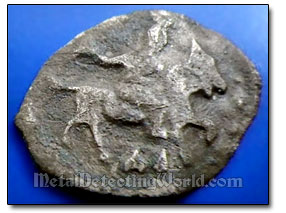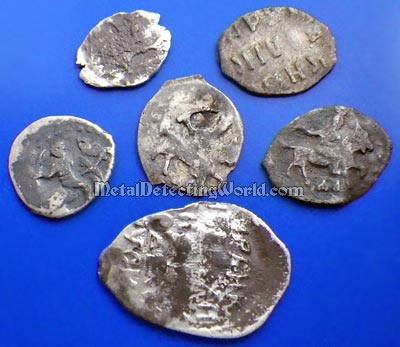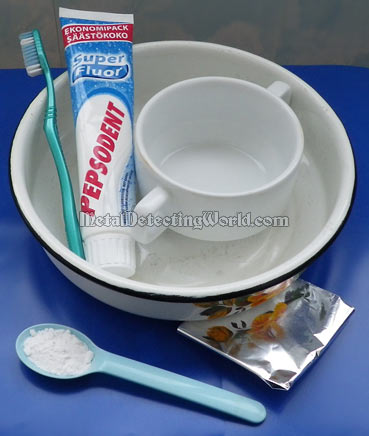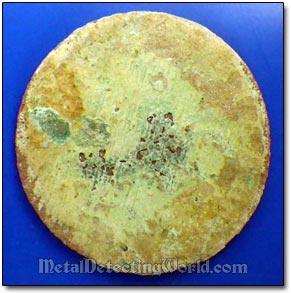Galvanic Removal of Tarnish From Silver Coins - Tutorial, page 1
Most Effective Method of Cleaning Coins by Electrochemical Reduction

Cleaning tarnished silver coins by Electrochemical Reduction - Galvanic cleaning, is based on spontaneous reduction half-reaction that takes place inside a galvanic cell.
In simple words, the process involves placing a silver coin in a non-metal container filled with electrolyte and surrounding the coin with a more active anodic metal, such as aluminum foil.
According to electrode potential that is provided by different positions of Silver and Aluminum in the electromotive force series (a table of Electromotive Force Series (EMF) for common metals is shown on page 15 of my "Guide To Cleaning Coins"), the redox reactions start immediately: the silver tarnish (silver sulphide) gets decomposed into its constituents - silver and sulphur, and the aluminum foil gets oxidized. These reactions are usually sped up by heating the electrolyte solution. The coin is treated until the aluminum foil gets completely oxidized, or until satisfactory results are achieved.
Although this method is quite effective, it has its limitation: it may fail to remove encrustation off the coin. In this case, either immersion into the hot bath of olive oil and lemon juice (this method is described on page 13 of my "Guide To Cleaning Coins") or Cleaning Coins with Electrolysis may help. However, this electrochemical reduction method is still more capable of removing silver tarnish than the chemical cleaning methods such as Treatment with Lemon Juice (method #7 on that page), Immersion in Ammonia Solution and Treatment with Lemon Acid.
To demonstrate this method's effectiveness, I selected six hammered silver coins (one of them is shown on a picture above), circa 16th-17th centuries, of the "Wire Money" Type that had unsuccessfully undergone the above-mentioned chemical treatments - the coins remained tarnished. As this galvanic cleaning method is presumably supposed to follow the chemical cleaning methods to achieve satisfactory results, and become the last stage of cleaning the tarnished silver coins, it was a great opportunity for me to prove it.
Tarnished Hammered Silver Coins Before Cleaning by Electrochemical Reduction

What Is Required for Making a Galvanic Cell
To make a galvanic cell for the electrochemical reduction cleaning of the tarnished silver coins, you need the following household items:
1) Sauté Pan or Tarte Tatin Pan or similar metal pan (shown below) for boiling water and heating up the galvanic cell.
2) Non-metal and heat-resistant glass or ceramic container, such as a double-handled soup bowl shown in a picture below, to hold all the galvanic cell's components: electrolyte, aluminum foil and coins.
3) Electrolyte is made of Washing Soda (sodium carbonate, Na2CO3) or Baking Soda (sodium bicarbonate, NaHCO3), or mix of both, and Distilled water. I use a teaspoon of baking soda for a cup of water; however, according to professional coin and artifact cleaners, the washing soda is supposed to give better effects.
If you feel lazy to go to the store and get the washing soda, you can make your own sodium carbonate at home. All you have to do is to take baking soda, spread it out onto a cookie sheet and bake it in the oven at 300°F (149°C) for an hour. The heat will drive away CO2 and water molecules; thus, making washing soda. Here is a formula of the process in case someone really needs it: 2NaHCO3 -> Na2Co3 + H20 + CO2.
NOTE: Do NOT use table salt for making the electrolyte! The table salt (sodium chloride, NaCl) is very corrosive and may do more harm than good. Sodium chloride reacts with silver to produce silver chloride which is also found as a corrosion product of silver. Pure silver chloride is a white or transparent compound. Encrustation of soot and dust combined in this silver chloride corrosion layer can turn it into a darker colour.
4) Aluminum foil is folded to make three layers and inlay the inside surface of the soup bowl. It is best to have an excessive amount of foil in the galvanic cell so that the reactions would not stop in the middle of the cleaning process.
5) Soft Toothbrush - for brushing the decomposed tarnish constituents off the coins during and after the process.
6) Pepsodent Toothpaste - for cleaning coins with the toothbrush.
Use These Household Items for Galvanic Cleaning of Coins

I decided to add an extra "spice" into my tutorial - to show you this cleaning method's effect on an encrusted copper coin, just to prove that the electrochemical reduction cleaning technique is not sufficient for cleaning tough cases of encrustation on copper coins.
Encrusted Copper Coin Before Galvanic Cleaning

This badly corroded copper coin will undergo the same treatment as the silver coins, and even for a longer time duration if necessary.
Back to 'Cleaning Silver Coins page 16'